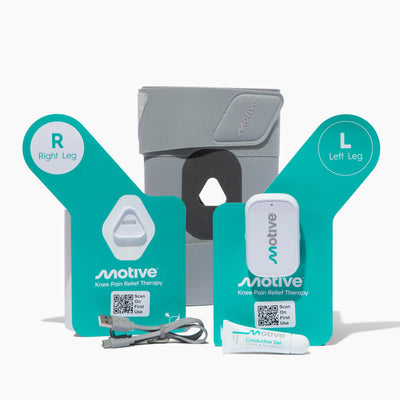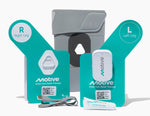
Knee stiffness affects millions globally, turning simple movements into challenging tasks. In fact, 40.7% of women and 20.5% of men worldwide report experiencing knee stiffness after periods of sitting, lying down, or resting during the day.
This article delves into the complexities of knee stiffness, exploring its common causes, symptoms, and effective remedies, including the innovative Motive Knee, designed to provide lasting relief and enhanced mobility.
Symptoms of Stiff Knee
A stiff knee manifests as a significant reduction in the knee joint's range of motion, often accompanied by pain when bending or straightening the leg. This condition is frequently experienced by those with knee osteoarthritis or rheumatoid arthritis but can also result from knee injuries or surgeries that lead to the formation of scar tissue or arthrofibrosis. Identifying these symptoms early is crucial for effective management and treatment.
Individuals with a stiff knee may also experience swelling, a feeling of tightness around the joint, and occasional 'popping' sounds during movement. It is imperative to monitor these symptoms closely, as they can progressively worsen without appropriate interventions and lifestyle adjustments.
Key Causes of Knee Stiffness
Knee stiffness can arise from various issues, including the aforementioned osteoarthritis and rheumatoid arthritis, but post-surgical stiffness is also prevalent. This often occurs after procedures like knee replacements or ACL repairs, where ligament injuries and meniscus tears have been addressed. Lifestyle factors, overuse, and lack of physical activity also contribute significantly to knee stiffness.
Injuries resulting in bursitis or the buildup of fluid in the knee's bursae can exacerbate stiffness and discomfort. Other common causes include patellar issues and the development of fibrous tissue within the knee, which can restrict movement and increase joint pain.
Diagnosing Stiff Knee
Accurate diagnosis is critical in effectively managing knee stiffness. Healthcare professionals typically conduct thorough physical examinations and use diagnostic tools like X-rays or MRI scans to assess the damage to cartilage, ligaments, and bones, including the femur, tibia, and patella. Understanding the underlying causes, which may range from meniscal damage to bursitis, is essential for determining appropriate treatment options.
Blood tests may also be used to rule out rheumatoid arthritis or other systemic conditions that could be contributing to the stiffness. Furthermore, consultations with orthopedic specialists can provide insights into the best nonsurgical or surgical treatment paths, depending on the severity and nature of the knee condition.
Solutions for Alleviating Stiff Knee
Treatment for knee stiffness varies depending on its cause but often includes a combination of physical therapy and medical interventions. Physical therapists may recommend specific exercises aimed at improving the range of motion and strengthening the quadriceps and hamstring muscles, which support the knee joint. For immediate pain relief, over-the-counter medications like ibuprofen are commonly used alongside low-impact activities to maintain joint health without exacerbating the problem.
Motive Knee can enhance these efforts by providing targeted electrical stimulation that further supports muscle strengthening in the quadriceps and results in pain relief. This innovative device works seamlessly with prescribed physical therapy routines, offering a proactive approach to alleviating knee stiffness and enhancing joint mobility.
Incorporating Motive Knee into Your Recovery Plan
Motive Knee enhances traditional treatment methods by providing targeted electrical stimulation therapy directly to the affected areas. This FDA-cleared device is particularly effective for chronic conditions like knee osteoarthritis, helping to alleviate joint stiffness and support the surrounding musculature, including the quadriceps and hamstrings.
The Motive Knee device is designed for easy integration into your daily routine, making it accessible and convenient for regular use. Motive Knee customers have reported significant improvements in their knee mobility and a reduction in stiffness after consistent application of the device. By reinforcing the effects of physical therapy exercises, Motive Knee can accelerate the recovery process and lead to long-term improvements in knee health.
Preventive Measures and Lifestyle Changes
To prevent the recurrence of knee stiffness, regular exercise, maintaining a healthy weight, and ergonomic adjustments in daily life are recommended. Using a knee brace during activities can also provide additional support and prevent further knee problems. Adopting a diet rich in anti-inflammatory foods can further aid in reducing symptoms of arthritis and support overall joint health.
Regularly scheduled consultations with healthcare professionals help monitor joint health and effectively adjust treatment plans as needed. Additionally, stretching exercises, particularly for the lower body, are crucial in maintaining flexibility and reducing the likelihood of stiffness recurring in the knee joint.
Enhanced Mobility with Motive
This comprehensive approach to managing knee stiffness—combining effective physical therapy, lifestyle adjustments, and advanced solutions like Motive Knee—can significantly enhance your mobility and reduce discomfort. By integrating Motive therapy into your routine, you gain access to a powerful tool that supports long-term knee health.
Motive therapy's targeted stimulation not only strengthens the muscles but also helps to minimize the daily impact and strain on your knees. As you continue to use the device, you'll notice improvements in your ability to perform daily activities with less pain and more stability. Its user-friendly design ensures that it can be easily incorporated into your everyday life, making your path to recovery smoother and more effective.
Don't let knee stiffness hold you back—explore how Motive therapy can transform your knee health by visiting our website or reaching out to a healthcare professional today.





